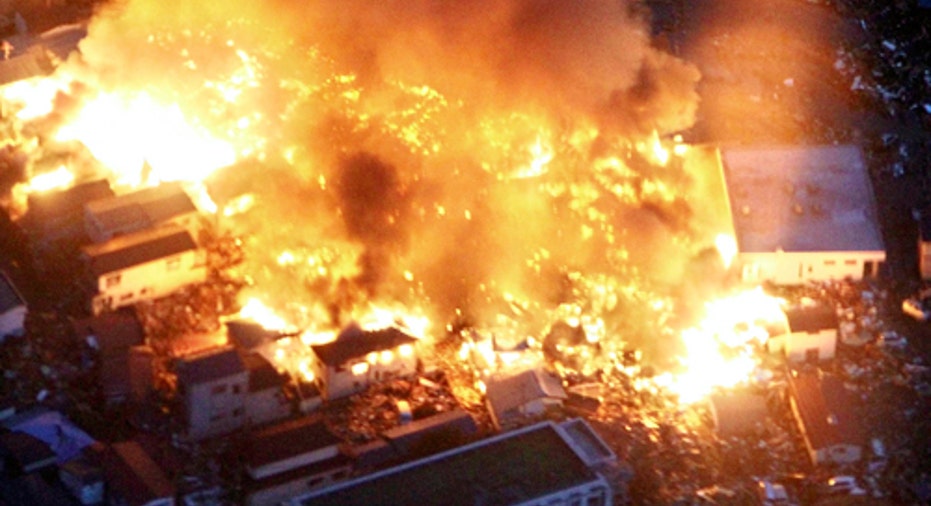Japan the Latest Victim of Tectonic 'Bad Luck'

Powerful killer earthquakes have rocked one corner of the globe to another in just over a year but scientists warn against looking for a Doomsday scenario in this recurring ripple of big earthshaking natural disasters.
"There's nothing going on out of the ordinary," Dr. Daniel McNamara, a research seismologist with the U.S. Geological Survey, told Reuters.
He said earthquakes, caused by shiftings and grindings of colliding tectonic plates beneath the planet's surface, were a natural phenomenon happening "all the time," with small tremors occurring in the tens of thousands each year.
Friday's 8.9 magnitude quake in Japan was the biggest on record in that earthquake-prone country.
The USGS said a magnitude 9 earthquake was equivalent to 25,000 nuclear bombs.
The Japan quake capped 14 months that saw a January 2010 7.0 magnitude jolt that devastated Haiti's capital, Port-au-Prince, and killed more than 300,000 people, followed by an 8.8 magnitude quake the next month in Chile that killed more than 500 people and caused $30 billion in damage.
This year, a Feb. 22 quake measuring 6.3 magnitude ravaged Christchurch, New Zealand, following an earlier nearby 7.1 quake in that country in September.
"We've just had bad luck, they've occurred in places near to centers of population and then it becomes news. If they occur in the middle of nowhere, they are not news," said Grenville Draper, professor of geosciences at the Earth and Environment Department of Florida International University.
He and McNamara said it was human nature to try to assign patterns to unfolding events, including catastrophes like earthquakes that lay bare human vulnerability in the face of powerful natural forces.
"We're the pattern recognition ape ... we're constantly looking for patterns and it tends to rather mislead us," said Draper. "We overinterpret at times."
McNamara said rapid advances in technology to measure and report tremors and earthquakes, plus intensified media coverage, may have contributed to "a false notion" that the world was seeing an increase in powerful deadly quakes.
"We are able to observe a lot more, a lot faster than we have been in the past," he said.
'WHERE" IS EASIER THAN 'WHEN'
McNamara and Draper said that while clusters of earthquake events could be seen concentrated around particular plate collision zones or fault lines, it was a stretch to try to link them to plate boundaries on the other end of the world.
"This is not something we can prove, it's very difficult to prove that the Chile earthquake is related to Japan, or something like this," McNamara said.
"We may establish these in the future, but right now that's not the case," he added.
While scientists had advanced in being able to foresee where earthquakes might occur -- the risk zones are on the edges of the world's tectonic plates -- predicting when they could happen was more difficult, if not impossible so far.
Experts were still searching for some kind of phenomena that could provide a warning for earthquakes.
"People have looked at different things in the past, they've looked at water levels in wells, they've even looked at insect behavior," Draper said.
But a reliable warning signal remained elusive, meaning that man's powerlessness in the face of an earthquake was probably greater than with any other natural disaster.
"You do feel totally helpless, it's like things are moving that shouldn't move and it's quite disorienting," said Draper.
But factors like the world's growing population and its concentration in major urban centers could increase the deadliness and destruction of earthquakes when they strike.
"If you think about it, the world is getting more populated, there are more of these large cities and many of them are in earthquake zones and so the potential for disaster is increased," Draper added.
Building codes also played a role. Impoverished Haiti's 7.0 quake was far more destructive and lethal than the larger quake in Chile, because of the poor quality, dangerous location and crowding of Port-au-Prince's buildings and flimsy hillside homes, many of which collapsed like packs of cards.
"The only way you can prepare is good construction, which is expensive. It's not like just buying some plywood to board up your windows for an oncoming hurricane," Draper said.
Despite the continuing unpredictability of earthquakes themselves, McNamara said experts had gotten better at being able to predict and prepare for volcano eruptions and tsunamis caused by earth movements.



















